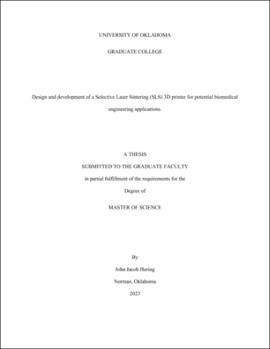| dc.description.abstract | An additive manufacturing method called Selective Laser Sintering (SLS) involves heating material particles to bond them together. Each two-dimensional layer is selectively sintered in the fabrication piston until the part is entirely manufactured. New layers are created by depositing material from the delivery piston to the fabrication piston, where the laser will follow the cross-sectional toolpath generated from a slicer. One of the most significant advantages of SLS 3D printing is that there is no need to have structural support for the material. The unused material provides support for the sintered shape throughout the whole process. Due to its biocompatibility and mechanical properties, sugar can be a biodegradable structure with many applications in biomedical engineering, such as sugar skeletons for tissue engineering and drug delivery [1]. Thus, this thesis examines the SLS process to print simple and complex geometry single-layer sugar samples. Each sample is designed to showcase the sintering capabilities and technology of an SLS 3D printer for potential biomedical engineering applications. Each sample is sliced into its cross-sectional layers using a non-proprietary software called Slic3r; its G-Code is translated to generate the lasers toolpath, then uploaded to the printer. The printing parameters such as heat chamber temperature, laser scanning speed, and laser intensity are the major determining factors in sample accuracy. Therefore, ideal printing parameters are discussed, and samples are evaluated through various tests. Results show that this printer can sinter single-layer sugar samples in multiple geometries to an acceptable level of accuracy. The printer is limited to two-dimensional printing. However, the results of the final samples indicate that this printer will be able to print in three dimensions in future research. | en_US |
